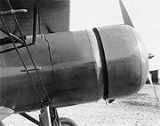
NACA cowling
Encyclopedia

Cowling
A cowling is the covering of a vehicle's engine, most often found on automobiles and aircraft.A cowling may be used:* for drag reduction* for engine cooling by directing airflow* as an air intake for jet engines* for decorative purposes...
is a type of aerodynamic fairing used to streamline
Streamliner
A streamliner is a vehicle incorporating streamlining in a shape providing reduced air resistance. The term is applied to high-speed railway trainsets of the 1930s to 1950s, and to their successor "bullet trains". Less commonly, the term is applied to fully faired recumbent bicycles...
radial engine
Radial engine
The radial engine is a reciprocating type internal combustion engine configuration in which the cylinders point outward from a central crankshaft like the spokes on a wheel...
s for use on airplane
Fixed-wing aircraft
A fixed-wing aircraft is an aircraft capable of flight using wings that generate lift due to the vehicle's forward airspeed. Fixed-wing aircraft are distinct from rotary-wing aircraft in which wings rotate about a fixed mast and ornithopters in which lift is generated by flapping wings.A powered...
s and developed by the National Advisory Committee for Aeronautics
National Advisory Committee for Aeronautics
The National Advisory Committee for Aeronautics was a U.S. federal agency founded on March 3, 1915 to undertake, promote, and institutionalize aeronautical research. On October 1, 1958 the agency was dissolved, and its assets and personnel transferred to the newly created National Aeronautics and...
in 1927. It was a major advancement in drag
Drag (physics)
In fluid dynamics, drag refers to forces which act on a solid object in the direction of the relative fluid flow velocity...
reduction, and paid for its development and installation costs many times over due to the gains in fuel efficiency
Fuel efficiency
Fuel efficiency is a form of thermal efficiency, meaning the efficiency of a process that converts chemical potential energy contained in a carrier fuel into kinetic energy or work. Overall fuel efficiency may vary per device, which in turn may vary per application, and this spectrum of variance is...
that it enabled.
History
NACA cowling was more than just streamlining: it improved engine cooling. The cowling enhanced speed through drag reduction and utilising the heat of the engine to generate thrust. The cowling constitutes a symmetric, circular airfoil, in contrast to the planar airfoil of wings.The test aircraft, a Curtiss AT-5A Hawk biplane, featuring a Wright Whirlwind J-5
Wright R-790
The Wright R-790 Whirlwind was a series of nine-cylinder air-cooled radial aircraft engines built by Wright Aeronautical Corporation, all of which had a displacement of about 790 in³ and around 200 hp...
radial engine, reached an airspeed of 137 miles per hour (61.2 m/s) equipped with the NACA cowling compared to 118 miles per hour (52.8 m/s) without it.
The NACA cowling directs cool air to flow through the engine where it is routed across the motor's hottest parts, i.e. the cylinders
Cylinder (engine)
A cylinder is the central working part of a reciprocating engine or pump, the space in which a piston travels. Multiple cylinders are commonly arranged side by side in a bank, or engine block, which is typically cast from aluminum or cast iron before receiving precision machine work...
and even more importantly, the cylinder heads. Furthermore, turbulence after the air passes the free-standing cylinders is greatly reduced. The sum of all these effects reduces drag by as much as 60%. The test conclusions resulted in almost every radial-engined aircraft being equipped with this cowling, starting in 1932.
External links
- NACA Low-Drag Engine Cowling Essay - details on development of the cowling.
- Abstract of NACA TN 301 report and .pdf file
- Archive of NACA reports 1917-1958

